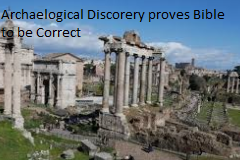Discoveries Prove Torah To Be Accurate

CRITICS OF BIBLE SILENCED ONCE AGAIN: Archaeological Discoveries Prove Torah To Be Accurate
AUG 02, 2015by ADMIN in JUDAISM
For many years, the critics of the Old Testament continued to argue that Moses invented the stories found in Genesis. The critics contended that the ancient people of the Old Testament times were too primitive to record documents with precise details.
In doing so, these critics basically claimed that there was no verification that the people and cities mentioned in the oldest of Biblical accounts ever really existed.
The discovery of the Ebla archive in northern Syria in the 1970′s confirmed that the Biblical records concerning the Patriarchs are spot on. It was during the excavations in northern Syria that the excavating found a large library inside a royal archive room. This library had tablets dating from 2400 -2300 BC.
The excavating team discovered almost 15,000 ancient tablets and fragments which when joined together accounted for about 2,500 tablets. Amazingly, these tablets confirmed that personal and location titles in the Biblical Patriarchal accounts are authentic. These tablets are known as the Ebla Tablets.
For a long period of time, the critics of the Old Testament used to argue that the name ‘Canaan’ was used wrongly in the early chapters of the Bible. They claimed the name Canaan was never used at that specific time in history. They further accused that the name was inserted in the Old Testament afterward, while the earliest books of The Holy Bible were not written in the times that are described.
However, with the discovery of the tablets from the northern Syria, the word the word “Canaan” does appear, contrary to the claims of the critics. The tablets proved that the term was actually used in ancient Syria during the time in which the Old Testament was written.
Additionally, the cities of Sodom and Gomorrah were also thought to be pure fiction by Bible critics. These cities are also identified in the Ebla tablets, in addition to the city of Haran. Haran is described in Genesis as the city of Abram’s father, Terah. Previous to this discovery, ‘scholars’ suspected the actual presence of the ancient city.
In addition to this, countless other archaeological findings confirm the Biblical records to be real and accurate. Some of these findings are listed below:
• The campaign into Israel by Pharaoh Shishak (1 Kings 14:25-26) is recorded on the walls of the Temple of Amun in Thebes, Egypt.
• The revolt of Moab against Israel (2 Kings 1:1; 3:4-27) is recorded on the Mesha Inscription.
• The fall of Samaria (2 Kings 17:3-6, 24; 18:9-11) to Sargon II, king of Assyria, is recorded on his palace walls.
• The defeat of Ashdod by Sargon II (Isaiah 20:1) is recorded on his palace walls.
• The campaign of the Assyrian king Sennacherib against Judah (2 Kings 18:13-16) is recorded on the Taylor Prism.
• The siege of Lachish by Sennacherib (2 Kings 18:14, 17) is recorded on the Lachish reliefs.
• The assassination of Sennacherib by his own sons (2 Kings 19:37) is recorded in the annals of his son Esarhaddon.
• The fall of Nineveh as predicted by the prophets Nahum and Zephaniah (2 Kings 2:13-15) is recorded on the Tablet of Nabopolasar.
• The fall of Jerusalem to Nebuchadnezzar, king of Babylon (2 Kings 24:10-14) is recorded in the Babylonian Chronicles.
• The captivity of Jehoiachin, king of Judah, in Babylon (2 Kings 24:15-16) is recorded on the Babylonian Ration Records.
• The fall of Babylon to the Medes and Persians (Daniel 5:30-31) is recorded on the Cyrus Cylinder.
• The freeing of captives in Babylon by Cyrus the Great (Ezra 1:1-4; 6:3-4) is recorded on the Cyrus Cylinder.
https://www.netivonline.org/critics-bible-silenced-archaeological-discoveries-prove-torah-accurate/
